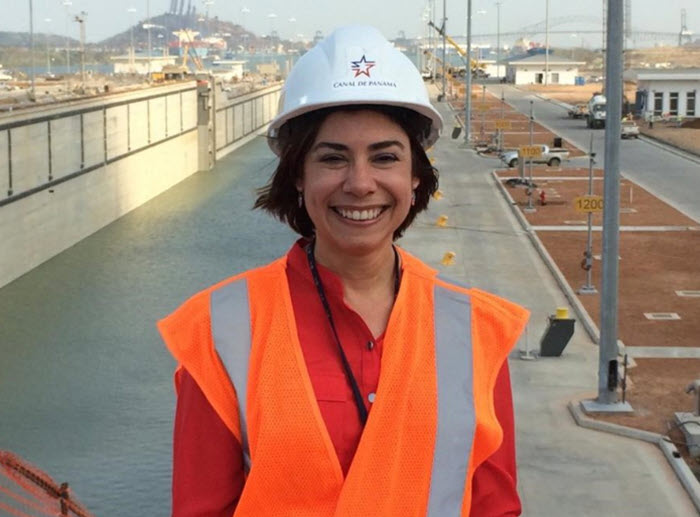Following a decade’s worth of planning and construction, the Expanded Canal was officially inaugurated on June 26, 2016, a historic moment for the waterway, as well as the people of Panama and the global maritime industry. The Expanded Canal has since come to represent the waterway’s ability to adapt and meet the industry’s growing needs, even when it involves taking on unprecedented challenges.
To celebrate this anniversary, we spoke with Silvia de Marucci, Manager of the Market Analysis & Customer Relations Division, to hear about the Expanded Canal’s operations and impact at the Panama Canal so far.
Can you describe the Expanded Canal’s offerings?
The expansion included the construction of a new set of locks on the Atlantic and Pacific sides of the waterway. This created a third lane of traffic that doubled the cargo capacity of the Panama Canal and paved the way for more shipping options, better maritime service, and heightened supply chain reliability.
The Expanded Canal also strengthened the waterway’s value as the green route of maritime trade. For one, despite being 70 feet wider and 18 feet deeper than those in the original Canal, the Neopanamax Locks use less water due to water-savings basins that recycle water during each transit. Their size also allows shippers to consolidate cargo on larger ships that take fewer trips, reducing emissions.
How has the Expanded Canal affected transits over the past four years?
In 2016, the Expanded Canal accounted for 8% of transits at the waterway. Since then, shippers have come to capitalize on the time- and cost-savings offered by the Expanded Canal, bringing new segments, larger quantities of existing segments, and rerouted shipping lines to the waterway. Four years later, the Expanded Canal now represents not only 27% of transits, but also 50% of tonnage at the Panama Canal.
How has the COVID-19 pandemic and related economic impact affected the Expanded Canal?
As the pandemic grew, we acted quickly to safeguard our sustained operations as well as the health of our workforce, customers, and the crew of ships in transit in response to the coronavirus pandemic. In March, the waterway instituted heightened procedures, including a reduction of on-site staff to only those essential for transit operations, and mandating their strict compliance with protocols set forth by the Panamanian health authorities.
So far, transits at the Expanded Canal have remained stable with an average of eight to nine transits per day. The Expanded Canal has also helped bolster the Panama Canal’s role in facilitating the passage of critical global supply chains in recent months, helped in part by the heightened capacity and efficiency provided by the Neopanamax Locks. So far in our 2020 Fiscal Year, over 13 million tons of cooking gas, 107,000 tons of groceries and 4.9 million tons of grains have traveled through the Neopanamax Locks on their way to communities around the world. Since February alone, the Neopanamax Locks have seen over 164,000 tons of wheat, equivalent to the weight of over twenty Eiffel Towers.
What does the future look like for the Panama Canal?
We are tracking temporary and permanent shifts in trade patterns, including a growing shift from global to regional trade, and evaluating ways to adapt our operations accordingly. Despite the current economic situation, we are still advancing plans to invest in our infrastructure, processes, and people, so we are prepared for our industry’s recovery and growth down the road.
One such opportunity includes implementing a long-term solution for water, which will strengthen the Panama Canal’s operational reliability for years to come. This is a top priority for our team, and one that may become the waterway’s second largest capital investment, second only to Expansion.
As the Administrator wrote in May, we see the Expanded Canal as a testament to our commitment to investing ambitiously in our future. For us, the Expansion is still just the beginning of our bright future as the logistics hub of the Americas.
Source: Panama Canal Authority
Stay Safe!!

